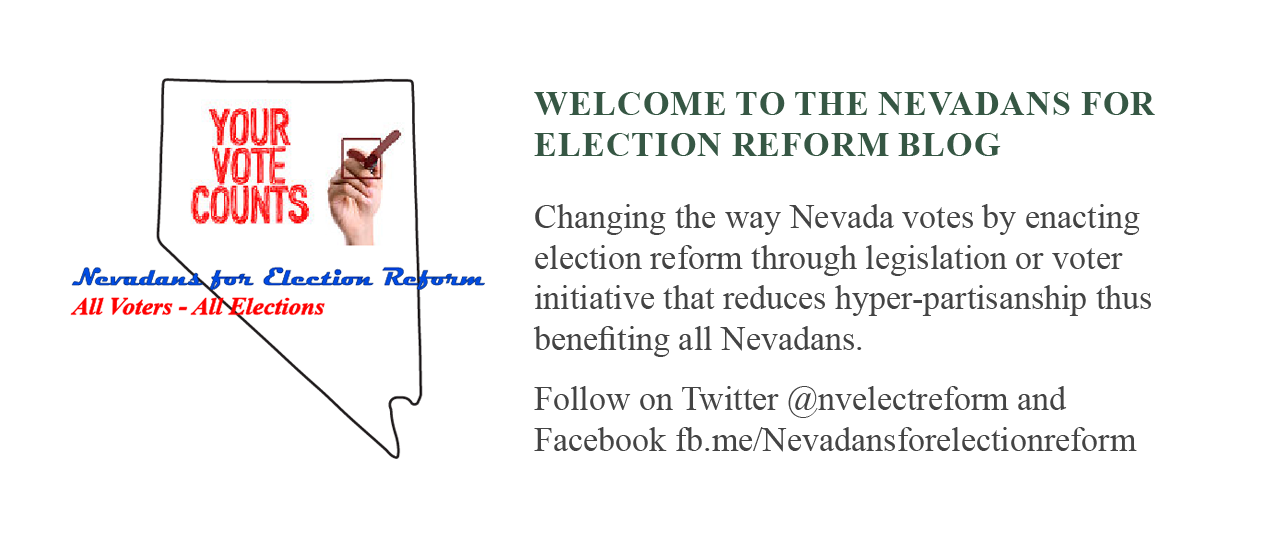In response to the veto, Assembly Speaker Jason Frierson was quoted in the Nevada Independent;
“Nevadans agree that we need to have a voting system that protects the fundamental right of every eligible voter— Democrat, Republican, non-partisan or otherwise. Voting is a right, not a privilege and we should make it easy for Nevadans to hold their own government accountable. While I’m disappointed by the governor’s decision to veto IP1, I look forward to the people having the final say in 2018.”
Does the Speaker's statement imply support for SB 103? In a top-two open primary election the right of every voter, regardless of party affiliation, to participate in publicly funded elections is protected. In a top-two open primary election the right of every candidate to face the voters in all phases of the election process is protected. With full participation as provided for in a top-two open primary, the opportunity for Nevadans to hold their elected officials accountable is maximized.
"..a voting system that protects the fundamental right of every eligible voter— Democrat, Republican, non-partisan or otherwise."
"Voting is a right, not a privilege.."
"..make it easy for Nevadans to hold their own government accountable."
In their Nevada Blueprint for the current session of the legislature, the Democratic Caucus is clearly focused on voting rights. "We also need to protect our heritage. That means preserving Nevada’s natural environment, protecting our constitutional rights, and making it easier for our citizens to participate in the democratic process."
"..making it easier for our citizens to participate in the democratic process."
Reading these statements I find it difficult understand Democratic opposition to SB 103. The only concerns I have heard is that a top-two open primary will not benefit the party and that if voters want to participate in the primary they can register in the party.
Benefits to the party? Yes. Voters have left and continue to leave or not affiliate with both major political parties because the parties do not represent them. This trend continues every month and is most pronounced among voter between the ages of 18 to 34. Under a top-two open primary, candidates must reach out to a broader range of voters. As this happens, the parties will return to representing those voters. Because the desire to belong is human nature, voters would most likely return to the parties. Also as the parties and their candidates demonstrate more inclusiveness they would most like draw more support.
Parties rights of association; voters can register if they want to participate in the primary? The U.S. Supreme Court has upheld that a top-two open primary where the top two vote getters, regardless of party affiliation, move forward to the general election does not violate a political party's right of association. Saying voters can join a party also ignores why voters are knowingly withdrawing from the process and why Non-Partisan is the only category gaining voter share across all demographics month after month while both the Democratic and Republican Party lose voter share.
Reading Speaker Frierson's statement on Governor Sandoval's veto of IP-1 and the Democratic Caucus' Nevada Blueprint, the assumption would be that the Democratic Caucus in the Nevada legislature would be in full support of SB 103. Instead it appears efforts to block even a hearing are in full swing.
Reading these statements I find it difficult understand Democratic opposition to SB 103. The only concerns I have heard is that a top-two open primary will not benefit the party and that if voters want to participate in the primary they can register in the party.
Benefits to the party? Yes. Voters have left and continue to leave or not affiliate with both major political parties because the parties do not represent them. This trend continues every month and is most pronounced among voter between the ages of 18 to 34. Under a top-two open primary, candidates must reach out to a broader range of voters. As this happens, the parties will return to representing those voters. Because the desire to belong is human nature, voters would most likely return to the parties. Also as the parties and their candidates demonstrate more inclusiveness they would most like draw more support.
Parties rights of association; voters can register if they want to participate in the primary? The U.S. Supreme Court has upheld that a top-two open primary where the top two vote getters, regardless of party affiliation, move forward to the general election does not violate a political party's right of association. Saying voters can join a party also ignores why voters are knowingly withdrawing from the process and why Non-Partisan is the only category gaining voter share across all demographics month after month while both the Democratic and Republican Party lose voter share.
Reading Speaker Frierson's statement on Governor Sandoval's veto of IP-1 and the Democratic Caucus' Nevada Blueprint, the assumption would be that the Democratic Caucus in the Nevada legislature would be in full support of SB 103. Instead it appears efforts to block even a hearing are in full swing.
